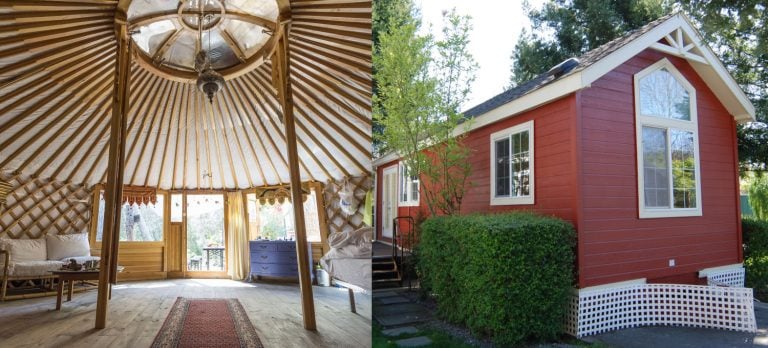Yurt Vs Shipping Container Home: Which Is Right for You?
You have just found the perfect plot of land, and now you are ready to construct your dream home. You want something that’s affordable, environmentally friendly, and unique. There are many options out there, but two popular choices are yurts and shipping container homes. They are both exciting options, but which one suits your needs best?
Yurts are more affordable and much easier to set up compared to container homes. But container homes are more durable, and they offer a lot more in terms of customization and space.
In this article, we will talk about the benefits and drawbacks of yurts and shipping containers, respectively, when it comes to building your dream home.
The Price of Yurt VS Container Home
When people are looking for alternative housing options, they often want to find freedom by lowering their living costs. Therefore, one thing that many consider when choosing their future home is the purchase price.
A 12-foot (113 sq ft) insulated yurt costs about $9,000. A 30-foot (707 sq ft) insulated yurt will run you around $20,000, going by the retail prices. Depending on the size, that is roughly between $28 and $80 per square foot. That is quite affordable compared to the $100 – $200 per square foot that it costs to build a house.
If you want to build your own shipping container home, expect to pay around $40 per square foot. This price will increase to $140 per square foot if you hire builders to do most of the work.
As you can tell, the costs of yurts and container homes vary greatly depending on size. This is because many of the expenses that go into building either of these homes involve noticeable start-up costs that will decrease the price of each additional square foot.
The main takeaway is that yurts are very low cost, but shipping container homes can also be very affordable when compared to traditional housing.
Size of Yurt Vs. Shipping Container Home
Due to their design and materials, yurts are relatively small structures. The largest models have just under 2,000 square feet of floor space, but most are smaller than 700 square feet. Shipping container homes can be any size you want, and they are usually built larger than most yurts.
Keep in mind that yurts do not work well for more than one family, whereas shipping container homes can easily be designed with this in mind. However, while most yurts will only accommodate two or three people, some models do come with the option of combining two or more yurts to create a larger living space for more people or additional storage space.
Shipping containers can be sized according to your needs, and they can be placed on top of each other to utilize vertical space and offer more privacy.
Design Freedom and Creativity
Yurts have many benefits, but their design limitations can be a drawback for some people. The round shape and preconstructed yurt floors, walls, and roof are a one-size-fits-all approach that doesn’t provide many design possibilities.
Of course, you can be creative with interior design and decor to make your yurt feel like your own home. But for those who want more freedom or a unique appearance, a container home might be the better option.
The modular design of shipping container homes can be a creative outlet for your design freedom. You can choose your container home’s shape, style, and materials to fit almost any specifications you want.
Container homes also offer more flexibility in terms of layout than yurts do because they are pre-built modules that can be put together as desired instead of having only one large room like yurts have. This provides a virtually unlimited number of different layouts and interior options and a wide variety of exterior designs.
Ease of Build
A significant upside to yurts is how quick and easy they are to set up. They can be assembled in one or two days and don’t require much in therm of skills or knowledge to make. This is great if you’re living in a temporary location and want to move somewhere else soon.
On the other hand, container homes take significantly longer to build because they require a foundation that needs to be poured first before construction can start. It also takes a long time to build and requires some specialized skills, including welding and some carpentry.
Lifespan and Durability of Yurt Vs. Shipping Container Home
Yurts and container homes are built from very different materials. The yurt is made from wood, canvas, and insulation. The container home is constructed with a metal frame and panels of corrugated steel. This means they require very different kinds of maintenance.
Yurts generally do not need much maintenance, but it’s vital to ensure sufficient ventilation to prevent mold or mildew. The outer canvas cover will also need to be replaced every 15 to 20 years. The yurt frame is more durable, but eventually, the top dome will need replacing too. On larger yurts, you will need machinery to replace these things.
Container homes require very little maintenance but should be painted periodically to protect them from corrosion due to weathering. Shipping containers are made from corrosion-resistant steel but will eventually rust if not properly cared for with paint or other means of protection. Read more about protecting container homes against corrosion here.
Zoning and Building Codes
As yurts and container homes are alternative housing options, they can sometimes be harder to get building permits for.
Shipping container homes can be made to look like regular houses, and they are relatively easy to build to code, but you may still face difficulties. In some locations, zoning may have very specific requirements that don’t allow alternative building materials like containers.
Sometimes container homes will also face opposition from neighbors and homeowner associations who may have difficulty understanding the concept of shipping containers being used for housing.
Depending on your location, yurts can be either much easier or much harder to get approved. In some cases, they are considered to be tents with no need for permits, whereas, in other jurisdictions, they are considered permanent structures that require a permit and approval. This often depends on whether you place it on a foundation or directly on the ground.
As zoning regulations (and sometimes building codes) vary from region to region, you should check with your local planning and zoning department. Regardless of whether you want to explore yurts or shipping container homes, it’s important that you do your research on the specific rules and regulations in your region before pursuing this type of home design. Your local county clerk should be able to help you navigate the bureaucratic process.
In Summary: Which One Is Right for You?
Yurts and container homes are both alternative living spaces, but they are also very different. What they do have in common, however, is that they are relatively simple constructions that can be much more affordable than a traditional house.
Yurts are simple, quick to build, and easy to move. They can be assembled in a very short time with the help of a few friends or family members. Container homes provide an opportunity for more space than yurts do. The downside is that they require more time and skills when it comes to construction because you’re building from scratch and working with metal.
So which one should you choose? It really depends on your needs and what you’re looking for. If you need more space and have a little more money, and time, container homes are probably the way to go. On the other hand, Yurts are a great choice for people who need something very affordable, quick, and easy that can be moved when needed.






